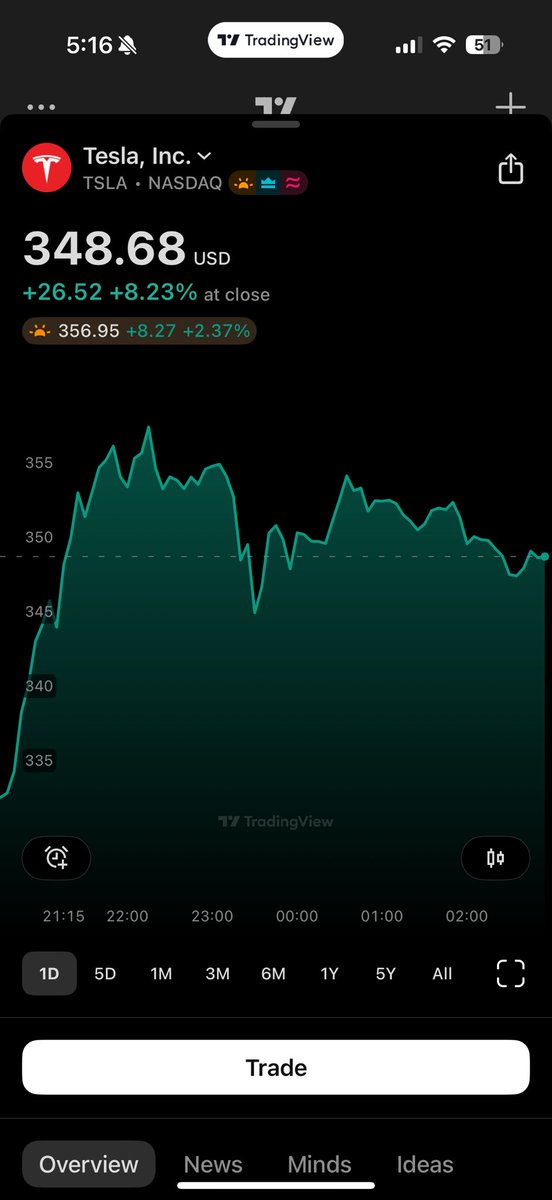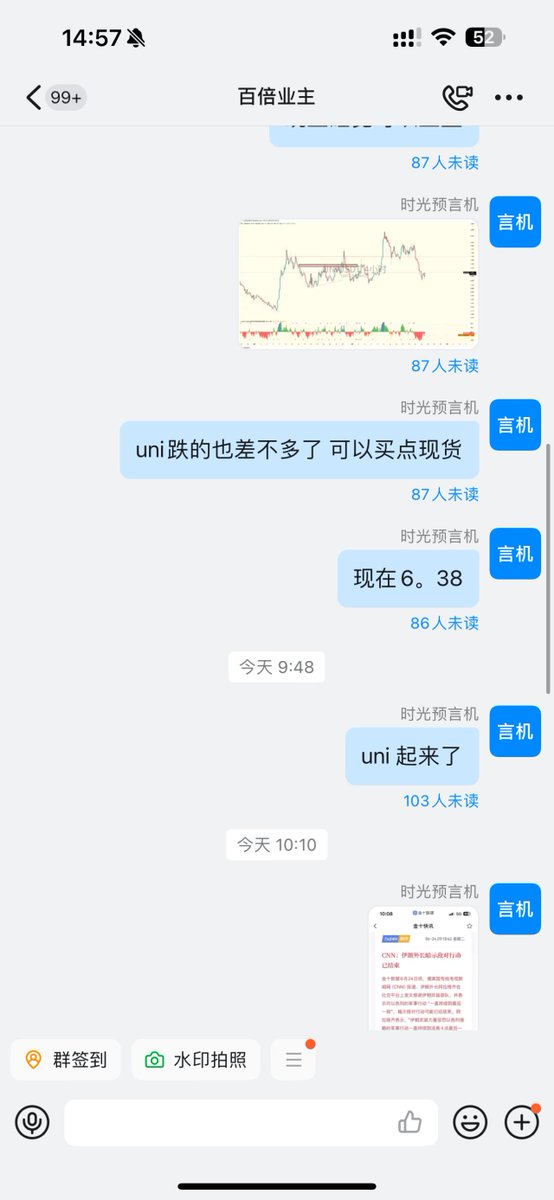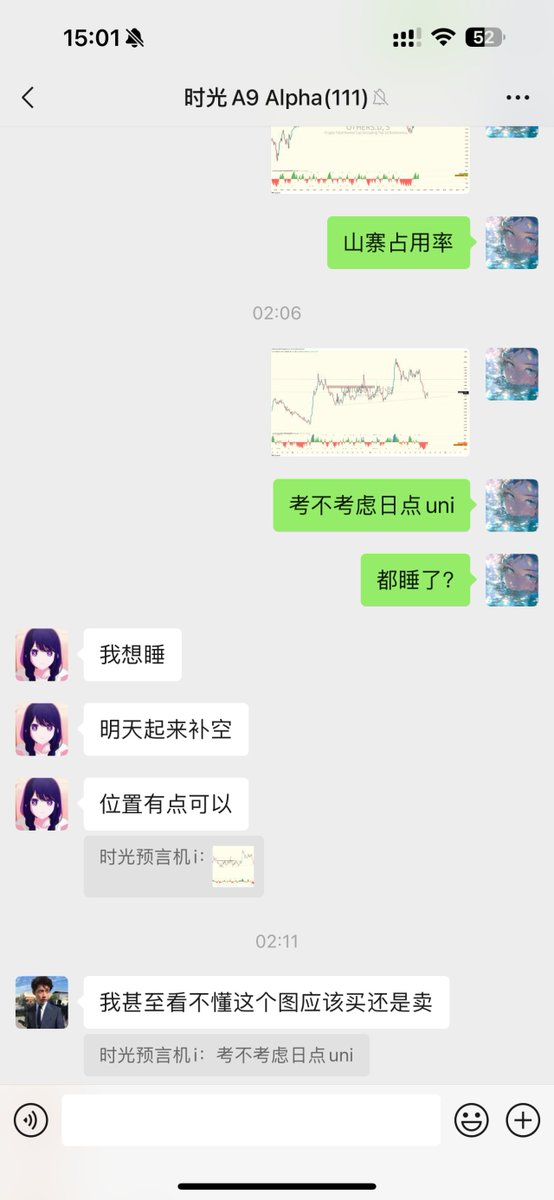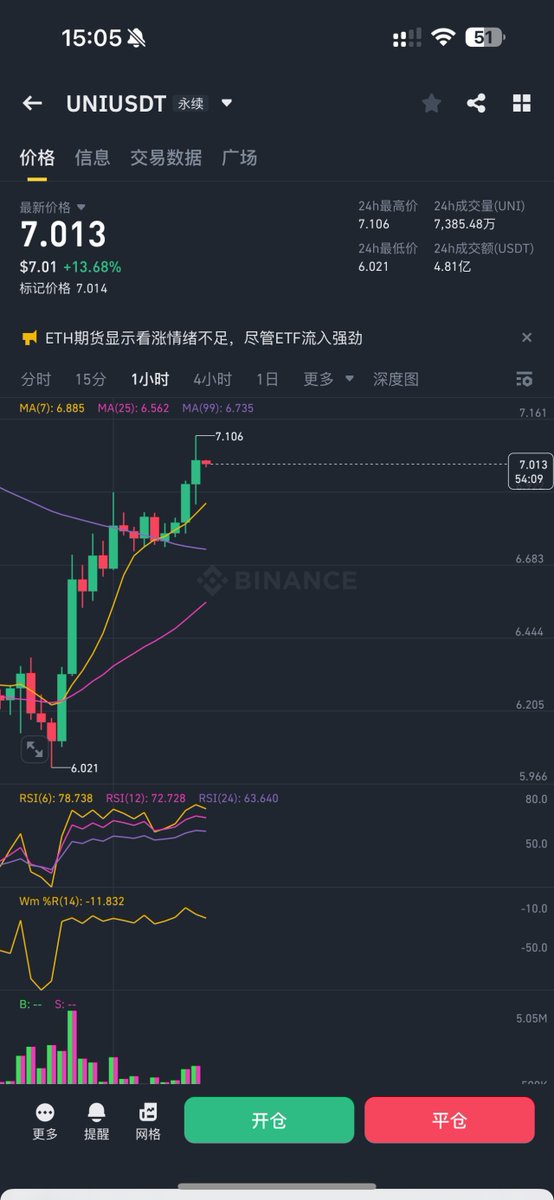
UNI
Uniswap Kurs
$6,8980
+$0,64800
(+10,36 %)
Preisänderung der letzten 24 Stunden

Was denken Sie heute über den UNI-Kurs?
Teilen Sie uns Ihre Meinung mit: Daumen nach oben, wenn Sie die Entwicklung des Solana-Kurses aktuell positiv einschätzen, oder Daumen nach unten, wenn Sie den Solana-Preis kritisch einschätzen.
Verfolgen Sie den Solana-Kurs-Chart, um Marktentwicklungen in Echtzeit zu analysieren.
Verfolgen Sie den Solana-Kurs-Chart, um Marktentwicklungen in Echtzeit zu analysieren.
Abstimmen und Ergebnisse anzeigen
Haftungsausschluss
Der soziale Inhalt auf dieser Seite („Inhalt”), einschließlich, aber nicht beschränkt auf Tweets und Statistiken, die von LunarCrush bereitgestellt werden, stammt von Dritten und wird „wie er ist” ausschließlich zu Informationszwecken bereitgestellt. OKX übernimmt keine Garantie für die Qualität oder Richtigkeit des Inhalts, und der Inhalt spiegelt nicht die Ansichten von OKX wider. Die Inhalte dienen nicht dazu, (i) Anlageberatung oder Empfehlungen zu geben, (ii) ein Angebot oder eine Aufforderung zum Kauf, Verkauf oder Halten digitaler Vermögenswerte darzustellen oder (iii) finanzielle, buchhalterische, rechtliche oder steuerliche Beratung zu leisten. Digitale Assets, einschließlich Stablecoins und NFTs, bergen ein hohes Risiko, können stark schwanken und sogar wertlos werden. Preis und Leistung digitaler Vermögenswerte sind nicht garantiert und können sich ohne Vorankündigung ändern.
OKX gibt keine Anlage- oder Vermögensempfehlungen. Du solltest gut abwägen, ob der Handel und das Halten von digitalen Assets angesichts deiner finanziellen Situation sinnvoll ist. Bei Fragen zu deiner individuellen Situation wende dich bitte an deinen Rechts-/Steuer- oder Anlagenexperten. Weitere Einzelheiten findest du in unseren Nutzungsbedingungen und der Risikowarnung. Durch die Nutzung der Website eines Drittanbieters („TPW“) akzeptieren Sie, dass jegliche Nutzung der TPW den Bedingungen der TPW unterliegt. Sofern nicht ausdrücklich schriftlich angegeben, steht OKX einschließlich seiner verbundenen Unternehmen („OKX“) in keinerlei Verbindung zum Eigentümer oder Betreiber der TPW. Sie stimmen zu, dass OKX nicht für Verluste, Schäden oder sonstige Folgen haftet, die sich aus Ihrer Nutzung der TPW ergeben. Bitte beachte, dass die Nutzung einer TPW zu einem Verlust oder einer Minderung deiner Assets führen kann. Das Produkt ist möglicherweise nicht in allen Ländern verfügbar.
OKX gibt keine Anlage- oder Vermögensempfehlungen. Du solltest gut abwägen, ob der Handel und das Halten von digitalen Assets angesichts deiner finanziellen Situation sinnvoll ist. Bei Fragen zu deiner individuellen Situation wende dich bitte an deinen Rechts-/Steuer- oder Anlagenexperten. Weitere Einzelheiten findest du in unseren Nutzungsbedingungen und der Risikowarnung. Durch die Nutzung der Website eines Drittanbieters („TPW“) akzeptieren Sie, dass jegliche Nutzung der TPW den Bedingungen der TPW unterliegt. Sofern nicht ausdrücklich schriftlich angegeben, steht OKX einschließlich seiner verbundenen Unternehmen („OKX“) in keinerlei Verbindung zum Eigentümer oder Betreiber der TPW. Sie stimmen zu, dass OKX nicht für Verluste, Schäden oder sonstige Folgen haftet, die sich aus Ihrer Nutzung der TPW ergeben. Bitte beachte, dass die Nutzung einer TPW zu einem Verlust oder einer Minderung deiner Assets führen kann. Das Produkt ist möglicherweise nicht in allen Ländern verfügbar.
Marktinformationen zu Uniswap
Marktkapitalisierung
Die Marktkapitalisierung wird durch Multiplikation der Umlaufmenge des Coins mit dem letzten Preis berechnet.
Marktkapitalisierung = Umlaufmenge × letzter Preis
Marktkapitalisierung = Umlaufmenge × letzter Preis
Umlaufmenge
Gesamtmenge eines Coins, die auf dem Markt öffentlich verfügbar ist.
Ranking der Marktkapitalisierung
Platzierung des Coins in Bezug auf die Marktkapitalisierung.
Allzeithoch
Höchster Preis, den ein Coin in seiner Handelsgeschichte erreicht hat.
Allzeittief
Niedrigster Preis, den ein Coin in seiner Handelshistorie erreicht hat.
Marktkapitalisierung
$4,17B
Umlaufmenge
600.483.074 UNI
60,04 % von
1.000.000.000 UNI
Ranking der Marktkapitalisierung
25
Prüfungen

Letzte Prüfung: --
24-Std.-Hoch
$7,0730
24-Std.-Tief
$6,0250
Allzeithoch
$44,9710
-84,67 % (-$38,0730)
Letzte Aktualisierung: 3. Mai 2021, (UTC+8)
Allzeittief
$1,0000
+589,80 % (+$5,8980)
Letzte Aktualisierung: 17. Sept. 2020, (UTC+8)
Uniswap-Feed
Der folgende Inhalt stammt von .

Xin Wan
Ja, wir sind jetzt ein KI-Unternehmen.

Uniswap Labs 🦄
KI-gestützte niederländische Auktionen in absichtsbasierten Systemen
25. Juni um 15:30 Uhr
Eine technische Sitzung mit @BradBachu darüber, wie KI und Auktionsdesign sich überschneiden, insbesondere im Kontext von absichtsbasierten Architekturen.
475
0
UNI-Rechner


Uniswap Preisentwicklung in USD
Der aktuelle Preis von Uniswap liegt bei $6,8980. In den letzten 24 Stunden hat sich Uniswap um gestiegen verändert – eine Entwicklung von +10,37 %. Aktuell beträgt die Umlaufmenge 600.483.074 UNI, das maximale Angebot liegt bei 1.000.000.000 UNI, was eine vollständig verwässerten Marktkapitalisierung von $4,17B ergibt. Derzeit belegt die Uniswap-Coin den 25. Platz im Ranking nach Marktkapitalisierung. Der Uniswap/USD-Preis wird in Echtzeit aktualisiert.
Heute
+$0,64800
+10,36 %
7 Tage
-$0,74500
-9,75 %
30 Tage
+$0,93300
+15,64 %
3 Monate
+$0,17300
+2,57 %
Beliebte Uniswap-Konvertierungen
Letzte Aktualisierung: 24.06.2025, 19:33
| 1 UNI in USD | 6,9480 $ |
| 1 UNI in EUR | 5,9848 € |
| 1 UNI in PHP | 395,78 ₱ |
| 1 UNI in IDR | 113.344,2 Rp |
| 1 UNI in GBP | 5,1051 £ |
| 1 UNI in CAD | 9,5278 $ |
| 1 UNI in AED | 25,5163 AED |
| 1 UNI in VND | 181.789,6 ₫ |
Über Uniswap (UNI)
Die angegebene Bewertung ist eine aggregierte Bewertung, die von OKX aus den angegebenen Quellen gesammelt wurde und nur zu Informationszwecken dient. OKX übernimmt keine Garantie für die Qualität oder Richtigkeit der Bewertungen. Es ist nicht beabsichtigt, (i) eine Anlageberatung oder -empfehlung, (ii) ein Angebot oder eine Aufforderung zum Kauf, Verkauf oder Halten von digitalen Vermögenswerten oder (iii) eine Finanz-, Buchhaltungs-, Rechts- oder Steuerberatung anzubieten. Digitale Vermögenswerte, einschließlich Stablecoins und NFTs, sind mit einem hohen Risiko behaftet, ihr Wert kann stark schwanken und sie können sogar wertlos werden. Der Preis und die Wertentwicklung der digitalen Vermögenswerte sind nicht garantiert und können sich ohne vorherige Ankündigung ändern. Ihre digitalen Vermögenswerte sind nicht durch eine Versicherung gegen mögliche Verluste abgedeckt. Historische Renditen sind kein Indikator für zukünftige Renditen. OKX garantiert keine Rendite, Rückzahlung von Kapital oder Zinsen. OKX gibt keine Anlage- oder Vermögensempfehlungen ab. Sie sollten sorgfältig abwägen, ob der Handel mit oder das Halten von digitalen Vermögenswerten angesichts Ihrer finanziellen Situation für Sie geeignet ist. Bitte konsultieren Sie Ihren Rechts-/Steuer-/Anlageexperten, wenn Sie Fragen bezüglich Ihrer individuellen Gegebenheiten haben.
Mehr anzeigen
- Offizielle Website
- Whitepaper
- Github
- Block Explorer
Über Websites von Drittanbietern
Über Websites von Drittanbietern
Durch die Nutzung der Website eines Drittanbieters (Third-Party Website, „TPW“) akzeptieren Sie, dass jegliche Nutzung der TPW den Bedingungen der TPW unterliegt und durch diese geregelt wird. Sofern nicht ausdrücklich schriftlich anders angegeben, stehen OKX und seine verbundenen Unternehmen („OKX“) in keiner Weise mit dem Eigentümer oder Betreiber der TPW in Verbindung. Sie erklären sich damit einverstanden, dass OKX nicht für Verluste, Schäden und sonstige Folgen haftet, die sich aus Ihrer Nutzung der TPW ergeben. Bitte beachten Sie, dass die Nutzung einer TPW zu einem Verlust oder einer Minderung Ihres Vermögens führen kann.
Häufig gestellte Fragen zum Uniswap-Preis
Was ist Uniswap?
Uniswap ist eine dezentrale Börse, die ursprünglich auf der Ethereum-Blockchain entwickelt wurde. Die Benutzer(innen) können sich mit der Uniswap Web-App verbinden und kostenlos ERC-20-Token handeln, sofern ausreichend Liquidität vorhanden ist. Uniswap ist nun auf Optimism, Arbitrum und der Polygon Layer-2-Blockchain verfügbar.
Wer ist der Gründer von Uniswap?
Uniswap wurde von Hayden Adams gegründet, einen ehemaligen Maschinenbauingenieur. Nachdem Adams seine Stelle bei Siemens verloren hat, riet ihm sein Freund Karl Floersch, Blockchain-Entwickler zu werden. Die Entwicklung des Uniswap-Projekts begann, nachdem Adams von einem Blog-Post von Vitalik Buterin über Automated Market Maker inspiriert wurde.
Wie kann ich meine UNI-Token verwenden?
Sie können Ihre UNI-Token verwenden, um mit der Web-App von Uniswap Liquiditäts-Pools einzurichten, Transaktionsgebühren einzuziehen und Prämien von Händlern und Händlerinnen zu verdienen. Durch das Halten von Uniswap-Token haben Sie das Recht, zu Governance-Vorschlägen abzustimmen, die die künftige Entwicklung der Uniswap-Plattform mitbestimmen.
Wie viel ist 1 Uniswap heute wert?
Aktuell liegt der Uniswap-Kurs bei $6,8980. Was kostet ein Uniswap? – die Antwort auf diese Frage hängt stark von Angebot, Nachfrage und Marktstimmung ab. Wenn Sie aktuelle Kursdaten und Einblicke in die Preisentwicklung suchen, sind Sie hier genau richtig. Entdecken Sie die neuesten Uniswap-Charts und handeln Sie verantwortungsbewusst mit OKX.
Was ist eine Kryptowährung?
Kryptowährungen, wie etwa Uniswap, sind digitale Vermögenswerte, die auf einem öffentlichen Hauptbuch namens Blockchains betrieben werden. Erfahren Sie mehr über die auf OKX angebotenen Coins und Tokens sowie deren unterschiedlichen Eigenschaften, einschließlich Live-Preisen und Charts in Echtzeit.
Wann wurden Kryptowährungen erfunden?
Dank der Finanzkrise von 2008 ist das Interesse an einem dezentralen Finanzwesen rasant gestiegen. Bitcoin bot als sicherer digitaler Vermögenswert auf einem dezentralen Netzwerk eine neuartige Lösung. Seitdem wurden auch viele andere Token, wie etwa Uniswap, erstellt.
Wird der Preis von Uniswap heute steigen?
Auf unserer Uniswap-Seite für Preisprognosen finden Sie Prognosen zukünftiger Preise und können Ihre Preisziele bestimmen.
ESG-Offenlegung
ESG-Regulierungen (Umwelt, Soziales und Governance) für Krypto-Vermögenswerte zielen darauf ab, ihre Umweltauswirkungen (z. B. energieintensives Mining) zu adressieren, Transparenz zu fördern und ethische Governance-Praktiken zu gewährleisten, um die Krypto-Industrie mit breiteren Nachhaltigkeits- und gesellschaftlichen Zielen in Einklang zu bringen. Diese Vorschriften fördern die Compliance mit Standards, die Risiken mindern und das Vertrauen in digitale Vermögenswerte stärken.
Details zum Vermögenswert
Name
OKcoin Europe LTD
Kennung der relevanten juristischen Person
54930069NLWEIGLHXU42
Name des Krypto-Vermögenswerts
Uniswap
Konsensmechanismus
Uniswap is present on the following networks: Arbitrum, Binance Smart Chain, Ethereum, Polygon.
Arbitrum is a Layer 2 solution on top of Ethereum that uses Optimistic Rollups to enhance scalability and reduce transaction costs. It assumes that transactions are valid by default and only verifies them if there's a challenge (optimistic): Core Components: • Sequencer: Orders transactions and creates batches for processing. • Bridge: Facilitates asset transfers between Arbitrum and Ethereum. • Fraud Proofs: Protect against invalid transactions through an interactive verification process. Verification Process: 1. Transaction Submission: Users submit transactions to the Arbitrum Sequencer, which orders and batches them. 2. State Commitment: These batches are submitted to Ethereum with a state commitment. 3. Challenge Period: Validators have a specific period to challenge the state if they suspect fraud. 4. Dispute Resolution: If a challenge occurs, the dispute is resolved through an iterative process to identify the fraudulent transaction. The final operation is executed on Ethereum to determine the correct state. 5. Rollback and Penalties: If fraud is proven, the state is rolled back, and the dishonest party is penalized. Security and Efficiency: The combination of the Sequencer, bridge, and interactive fraud proofs ensures that the system remains secure and efficient. By minimizing on-chain data and leveraging off-chain computations, Arbitrum can provide high throughput and low fees.
Binance Smart Chain (BSC) uses a hybrid consensus mechanism called Proof of Staked Authority (PoSA), which combines elements of Delegated Proof of Stake (DPoS) and Proof of Authority (PoA). This method ensures fast block times and low fees while maintaining a level of decentralization and security. Core Components 1. Validators (so-called “Cabinet Members”): Validators on BSC are responsible for producing new blocks, validating transactions, and maintaining the network’s security. To become a validator, an entity must stake a significant amount of BNB (Binance Coin). Validators are selected through staking and voting by token holders. There are 21 active validators at any given time, rotating to ensure decentralization and security. 2. Delegators: Token holders who do not wish to run validator nodes can delegate their BNB tokens to validators. This delegation helps validators increase their stake and improves their chances of being selected to produce blocks. Delegators earn a share of the rewards that validators receive, incentivizing broad participation in network security. 3. Candidates: Candidates are nodes that have staked the required amount of BNB and are in the pool waiting to become validators. They are essentially potential validators who are not currently active but can be elected to the validator set through community voting. Candidates play a crucial role in ensuring there is always a sufficient pool of nodes ready to take on validation tasks, thus maintaining network resilience and decentralization. Consensus Process 4. Validator Selection: Validators are chosen based on the amount of BNB staked and votes received from delegators. The more BNB staked and votes received, the higher the chance of being selected to validate transactions and produce new blocks. The selection process involves both the current validators and the pool of candidates, ensuring a dynamic and secure rotation of nodes. 5. Block Production: The selected validators take turns producing blocks in a PoA-like manner, ensuring that blocks are generated quickly and efficiently. Validators validate transactions, add them to new blocks, and broadcast these blocks to the network. 6. Transaction Finality: BSC achieves fast block times of around 3 seconds and quick transaction finality. This is achieved through the efficient PoSA mechanism that allows validators to rapidly reach consensus. Security and Economic Incentives 7. Staking: Validators are required to stake a substantial amount of BNB, which acts as collateral to ensure their honest behavior. This staked amount can be slashed if validators act maliciously. Staking incentivizes validators to act in the network's best interest to avoid losing their staked BNB. 8. Delegation and Rewards: Delegators earn rewards proportional to their stake in validators. This incentivizes them to choose reliable validators and participate in the network’s security. Validators and delegators share transaction fees as rewards, which provides continuous economic incentives to maintain network security and performance. 9. Transaction Fees: BSC employs low transaction fees, paid in BNB, making it cost-effective for users. These fees are collected by validators as part of their rewards, further incentivizing them to validate transactions accurately and efficiently.
The crypto-asset's Proof-of-Stake (PoS) consensus mechanism, introduced with The Merge in 2022, replaces mining with validator staking. Validators must stake at least 32 ETH every block a validator is randomly chosen to propose the next block. Once proposed the other validators verify the blocks integrity. The network operates on a slot and epoch system, where a new block is proposed every 12 seconds, and finalization occurs after two epochs (~12.8 minutes) using Casper-FFG. The Beacon Chain coordinates validators, while the fork-choice rule (LMD-GHOST) ensures the chain follows the heaviest accumulated validator votes. Validators earn rewards for proposing and verifying blocks, but face slashing for malicious behavior or inactivity. PoS aims to improve energy efficiency, security, and scalability, with future upgrades like Proto-Danksharding enhancing transaction efficiency.
Polygon, formerly known as Matic Network, is a Layer 2 scaling solution for Ethereum that employs a hybrid consensus mechanism. Here’s a detailed explanation of how Polygon achieves consensus: Core Concepts 1. Proof of Stake (PoS): Validator Selection: Validators on the Polygon network are selected based on the number of MATIC tokens they have staked. The more tokens staked, the higher the chance of being selected to validate transactions and produce new blocks. Delegation: Token holders who do not wish to run a validator node can delegate their MATIC tokens to validators. Delegators share in the rewards earned by validators. 2. Plasma Chains: Off-Chain Scaling: Plasma is a framework for creating child chains that operate alongside the main Ethereum chain. These child chains can process transactions off-chain and submit only the final state to the Ethereum main chain, significantly increasing throughput and reducing congestion. Fraud Proofs: Plasma uses a fraud-proof mechanism to ensure the security of off-chain transactions. If a fraudulent transaction is detected, it can be challenged and reverted. Consensus Process 3. Transaction Validation: Transactions are first validated by validators who have staked MATIC tokens. These validators confirm the validity of transactions and include them in blocks. 4. Block Production: Proposing and Voting: Validators propose new blocks based on their staked tokens and participate in a voting process to reach consensus on the next block. The block with the majority of votes is added to the blockchain. Checkpointing: Polygon uses periodic checkpointing, where snapshots of the Polygon sidechain are submitted to the Ethereum main chain. This process ensures the security and finality of transactions on the Polygon network. 5. Plasma Framework: Child Chains: Transactions can be processed on child chains created using the Plasma framework. These transactions are validated off-chain and only the final state is submitted to the Ethereum main chain. Fraud Proofs: If a fraudulent transaction occurs, it can be challenged within a certain period using fraud proofs. This mechanism ensures the integrity of off-chain transactions. Security and Economic Incentives 6. Incentives for Validators: Staking Rewards: Validators earn rewards for staking MATIC tokens and participating in the consensus process. These rewards are distributed in MATIC tokens and are proportional to the amount staked and the performance of the validator. Transaction Fees: Validators also earn a portion of the transaction fees paid by users. This provides an additional financial incentive to maintain the network’s integrity and efficiency. 7. Delegation: Shared Rewards: Delegators earn a share of the rewards earned by the validators they delegate to. This encourages more token holders to participate in securing the network by choosing reliable validators. 8. Economic Security: Slashing: Validators can be penalized for malicious behavior or failure to perform their duties. This penalty, known as slashing, involves the loss of a portion of their staked tokens, ensuring that validators act in the best interest of the network.
Anreizmechanismen und anfallende Gebühren
Uniswap is present on the following networks: Arbitrum, Binance Smart Chain, Ethereum, Polygon.
Arbitrum One, a Layer 2 scaling solution for Ethereum, employs several incentive mechanisms to ensure the security and integrity of transactions on its network. The key mechanisms include: 1. Validators and Sequencers: o Sequencers are responsible for ordering transactions and creating batches that are processed off-chain. They play a critical role in maintaining the efficiency and throughput of the network. o Validators monitor the sequencers' actions and ensure that transactions are processed correctly. Validators verify the state transitions and ensure that no invalid transactions are included in the batches. 2. Fraud Proofs: o Assumption of Validity: Transactions processed off-chain are assumed to be valid. This allows for quick transaction finality and high throughput. o Challenge Period: There is a predefined period during which anyone can challenge the validity of a transaction by submitting a fraud proof. This mechanism acts as a deterrent against malicious behavior. o Dispute Resolution: If a challenge is raised, an interactive verification process is initiated to pinpoint the exact step where fraud occurred. If the challenge is valid, the fraudulent transaction is reverted, and the dishonest actor is penalized. 3. Economic Incentives: o Rewards for Honest Behavior: Participants in the network, such as validators and sequencers, are incentivized through rewards for performing their duties honestly and efficiently. These rewards come from transaction fees and potentially other protocol incentives. o Penalties for Malicious Behavior: Participants who engage in dishonest behavior or submit invalid transactions are penalized. This can include slashing of staked tokens or other forms of economic penalties, which serve to discourage malicious actions. Fees on the Arbitrum One Blockchain 1. Transaction Fees: o Layer 2 Fees: Users pay fees for transactions processed on the Layer 2 network. These fees are typically lower than Ethereum mainnet fees due to the reduced computational load on the main chain. o Arbitrum Transaction Fee: A fee is charged for each transaction processed by the sequencer. This fee covers the cost of processing the transaction and ensuring its inclusion in a batch. 2. L1 Data Fees: o Posting Batches to Ethereum: Periodically, the state updates from the Layer 2 transactions are posted to the Ethereum mainnet as calldata. This involves a fee, known as the L1 data fee, which accounts for the gas required to publish these state updates on Ethereum. o Cost Sharing: Because transactions are batched, the fixed costs of posting state updates to Ethereum are spread across multiple transactions, making it more cost-effective for users.
Binance Smart Chain (BSC) uses the Proof of Staked Authority (PoSA) consensus mechanism to ensure network security and incentivize participation from validators and delegators. Incentive Mechanisms 1. Validators: Staking Rewards: Validators must stake a significant amount of BNB to participate in the consensus process. They earn rewards in the form of transaction fees and block rewards. Selection Process: Validators are selected based on the amount of BNB staked and the votes received from delegators. The more BNB staked and votes received, the higher the chances of being selected to validate transactions and produce new blocks. 2. Delegators: Delegated Staking: Token holders can delegate their BNB to validators. This delegation increases the validator's total stake and improves their chances of being selected to produce blocks. Shared Rewards: Delegators earn a portion of the rewards that validators receive. This incentivizes token holders to participate in the network’s security and decentralization by choosing reliable validators. 3. Candidates: Pool of Potential Validators: Candidates are nodes that have staked the required amount of BNB and are waiting to become active validators. They ensure that there is always a sufficient pool of nodes ready to take on validation tasks, maintaining network resilience. 4. Economic Security: Slashing: Validators can be penalized for malicious behavior or failure to perform their duties. Penalties include slashing a portion of their staked tokens, ensuring that validators act in the best interest of the network. Opportunity Cost: Staking requires validators and delegators to lock up their BNB tokens, providing an economic incentive to act honestly to avoid losing their staked assets. Fees on the Binance Smart Chain 5. Transaction Fees: Low Fees: BSC is known for its low transaction fees compared to other blockchain networks. These fees are paid in BNB and are essential for maintaining network operations and compensating validators. Dynamic Fee Structure: Transaction fees can vary based on network congestion and the complexity of the transactions. However, BSC ensures that fees remain significantly lower than those on the Ethereum mainnet. 6. Block Rewards: Incentivizing Validators: Validators earn block rewards in addition to transaction fees. These rewards are distributed to validators for their role in maintaining the network and processing transactions. 7. Cross-Chain Fees: Interoperability Costs: BSC supports cross-chain compatibility, allowing assets to be transferred between Binance Chain and Binance Smart Chain. These cross-chain operations incur minimal fees, facilitating seamless asset transfers and improving user experience. 8. Smart Contract Fees: Deployment and Execution Costs: Deploying and interacting with smart contracts on BSC involves paying fees based on the computational resources required. These fees are also paid in BNB and are designed to be cost-effective, encouraging developers to build on the BSC platform.
The crypto-asset's PoS system secures transactions through validator incentives and economic penalties. Validators stake at least 32 ETH and earn rewards for proposing blocks, attesting to valid ones, and participating in sync committees. Rewards are paid in newly issued ETH and transaction fees. Under EIP-1559, transaction fees consist of a base fee, which is burned to reduce supply, and an optional priority fee (tip) paid to validators. Validators face slashing if they act maliciously and incur penalties for inactivity. This system aims to increase security by aligning incentives while making the crypto-asset's fee structure more predictable and deflationary during high network activity.
Polygon uses a combination of Proof of Stake (PoS) and the Plasma framework to ensure network security, incentivize participation, and maintain transaction integrity. Incentive Mechanisms 1. Validators: Staking Rewards: Validators on Polygon secure the network by staking MATIC tokens. They are selected to validate transactions and produce new blocks based on the number of tokens they have staked. Validators earn rewards in the form of newly minted MATIC tokens and transaction fees for their services. Block Production: Validators are responsible for proposing and voting on new blocks. The selected validator proposes a block, and other validators verify and validate it. Validators are incentivized to act honestly and efficiently to earn rewards and avoid penalties. Checkpointing: Validators periodically submit checkpoints to the Ethereum main chain, ensuring the security and finality of transactions processed on Polygon. This provides an additional layer of security by leveraging Ethereum's robustness. 2. Delegators: Delegation: Token holders who do not wish to run a validator node can delegate their MATIC tokens to trusted validators. Delegators earn a portion of the rewards earned by the validators, incentivizing them to choose reliable and performant validators. Shared Rewards: Rewards earned by validators are shared with delegators, based on the proportion of tokens delegated. This system encourages widespread participation and enhances the network's decentralization. 3. Economic Security: Slashing: Validators can be penalized through a process called slashing if they engage in malicious behavior or fail to perform their duties correctly. This includes double-signing or going offline for extended periods. Slashing results in the loss of a portion of the staked tokens, acting as a strong deterrent against dishonest actions. Bond Requirements: Validators are required to bond a significant amount of MATIC tokens to participate in the consensus process, ensuring they have a vested interest in maintaining network security and integrity. Fees on the Polygon Blockchain 4. Transaction Fees: Low Fees: One of Polygon's main advantages is its low transaction fees compared to the Ethereum main chain. The fees are paid in MATIC tokens and are designed to be affordable to encourage high transaction throughput and user adoption. Dynamic Fees: Fees on Polygon can vary depending on network congestion and transaction complexity. However, they remain significantly lower than those on Ethereum, making Polygon an attractive option for users and developers. 5. Smart Contract Fees: Deployment and Execution Costs: Deploying and interacting with smart contracts on Polygon incurs fees based on the computational resources required. These fees are also paid in MATIC tokens and are much lower than on Ethereum, making it cost-effective for developers to build and maintain decentralized applications (dApps) on Polygon. 6. Plasma Framework: State Transfers and Withdrawals: The Plasma framework allows for off-chain processing of transactions, which are periodically batched and committed to the Ethereum main chain. Fees associated with these processes are also paid in MATIC tokens, and they help reduce the overall cost of using the network.
Beginn des Zeitraums, auf die sich die Angaben beziehen
2024-06-14
Ende des Zeitraums, auf die sich die Angaben beziehen
2025-06-14
Energiebericht
Energieverbrauch
5632.78639 (kWh/a)
Quellen und Verfahren im Bezug auf den Energieverbrauch
The energy consumption of this asset is aggregated across multiple components:
To determine the energy consumption of a token, the energy consumption of the network(s) arbitrum, binance_smart_chain, ethereum, polygon is calculated first. For the energy consumption of the token, a fraction of the energy consumption of the network is attributed to the token, which is determined based on the activity of the crypto-asset within the network. When calculating the energy consumption, the Functionally Fungible Group Digital Token Identifier (FFG DTI) is used - if available - to determine all implementations of the asset in scope. The mappings are updated regularly, based on data of the Digital Token Identifier Foundation.
UNI-Rechner



























Soziales